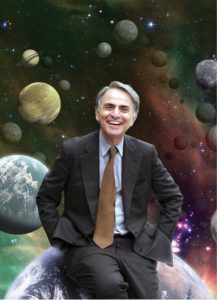
NASA
In October 2017, to mark the fortieth anniversary of NASA’s Voyager mission, the University assembled an expert panel in Bailey Hall. Among them was Carl Sagan’s widow, Ann Druyan, who’d served as creative director of the Voyager Interstellar Message Project. “In my memory, Carl’s last perfect public day was in this auditorium,” she observed at one point, going on to describe a lecture the famed astronomer gave during a two-day symposium on the occasion of his sixtieth birthday. “In my recollection—and I attended every one of his talks for twenty years—this was the greatest one he ever gave.”
The lecture in question was delivered in November 1994, two years before Sagan died from complications of a blood cancer. For decades, it was thought to be lost—until a happy coincidence returned it to public view. Druyan’s reminiscence at the Voyager event rang a bell for a University Relations staffer, who remembered having come across a Sony Betacam recording of the lecture years earlier while doing research for another project. “When I heard someone had found the tape, I couldn’t believe it,” says astronomy professor Lisa Kaltenegger, director of the Cornell-based Carl Sagan Institute. “I thought, This can’t be real.” The lecture was posted to YouTube last November—timed to celebrate what would have been Sagan’s eighty-fourth birthday—and garnered more than 55,000 views in its first month. “A new Sagan video, twenty years later,” noted one commenter. “It’s like Christmas.” Said another: “Everyone on the planet should see this.”
Sagan’s lecture was entitled “The Age of Exploration”—a topic he chose, as he jokingly admitted, because it was “sufficiently broad and ambiguous” that it would fit whatever he decided to talk about. Weaving through the history of human evolution, Sagan discussed our species’ tendency to cling to chauvinistic beliefs, from the idea that humans are the greatest form of life on Earth to our conviction that our planet lies at the center of the universe. (In actuality, he noted, we live in the “galactic boondocks.”) This parochial way of thinking, Sagan observed, comes from “the same psychic wellsprings that say that our gender, or our ethnic group, or our particular melanin content in the skin . . . is important and central, and all those alternative ways of being human are somehow less central, less important, less worthy than we are.”
Viewing the lecture for the first time, Kaltenegger says she was struck by how relevant Sagan’s subject matter remains, two decades later—and how approachable he seemed. “He was so relaxed, making jokes and laughing,” she says. “My favorite part was the question and answer portion. He was just as eloquent as he was during his talk.” Sagan fielded all manner of queries, from his views on animal testing and the existence of God to his opinion of astrology and clairvoyance to the likelihood that aliens had visited our planet. “He didn’t take anyone down, or say, ‘You really shouldn’t believe that,’ ” she observes. “He took people seriously.”
Sagan closed the talk with an arresting image taken by Voyager 1: from more than 37 billion miles away, Earth appears a mere marble. “It’s a pale blue dot,” he said, employing a phrase that has since become inextricably linked to his legacy. “That’s where we are. The aggregate of all our joy and suffering . . . every creator and destroyer of civilizations, every king and peasant, every young couple in love, every hopeful child . . . every saint and sinner in the history of our species lived there. To me, this picture underscores our responsibility to deal more kindly with one another and to preserve and cherish the pale blue dot, the only home we’ve ever known.”


